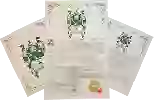
Winery Stephane MoulinierCôtes du Rhône
This wine generally goes well with beef, game (deer, venison) or lamb.
Food and wine pairings with Côtes du Rhône
Pairings that work perfectly with Côtes du Rhône
Original food and wine pairings with Côtes du Rhône
The Côtes du Rhône of Winery Stephane Moulinier matches generally quite well with dishes of beef, lamb or game (deer, venison) such as recipes of beef tongue with mushrooms, couscous of meat and fish or duck with vanilla (reunion island).
Details and technical informations about Winery Stephane Moulinier's Côtes du Rhône.
Discover the grape variety: Completer
Very old vine cultivated in Switzerland (canton of Grisons) where writings relating its presence were found in Malans dating from 1321, its origin would however be Italian. It is related to the white humagne, the bondola bianca, the bondoletta, the marzemino and the lafnetscha its mother. It should be noted that the Completer is today little multiplied in Switzerland, almost unknown in France and even less in the other wine-producing countries.
Informations about the Winery Stephane Moulinier
The Winery Stephane Moulinier is one of of the world's greatest estates. It offers 7 wines for sale in the of Côtes-du-Rhône to come and discover on site or to buy online.
The wine region of Côtes-du-Rhône
The wine region of Côtes-du-Rhône is located in the region of Rhône méridional of Rhone Valley of France. Wineries and vineyards like the Château de Beaucastel or the Chateau de Fonsalette produce mainly wines red, white and pink. The most planted grape varieties in the region of Côtes-du-Rhône are Mourvèdre, Viognier and Marsanne, they are then used in wines in blends or as a single variety. On the nose of Côtes-du-Rhône often reveals types of flavors of pineapple, red plum or sour cherry and sometimes also flavors of truffle, juniper or clove.
The wine region of Rhone Valley
The Rhone Valley is a key wine-producing region in Southeastern France. It follows the North-south course of the Rhône for nearly 240 km, from Lyon to the Rhône delta (Bouches-du-Rhône), near the Mediterranean coast. The Length of the valley means that Rhône wines are the product of a wide variety of soil types and mesoclimates. The viticultural areas of the region cover such a distance that there is a widely accepted division between its northern and southern parts.
The word of the wine: Lies
A deposit formed by dead yeast after fermentation. Some white wines are aged on their lees, which makes their aromas and structure more complex and richer.














